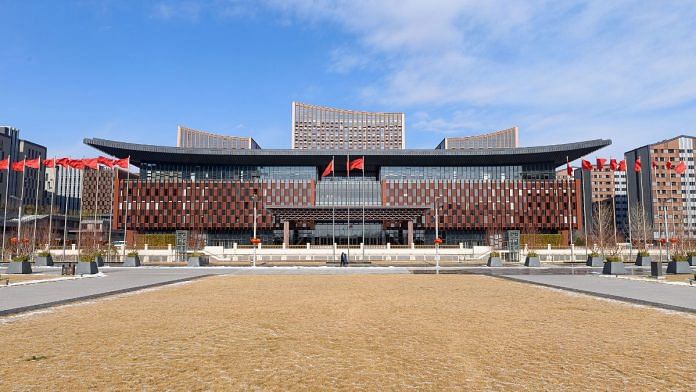Xi Jinping’s techno-socialist utopia, called Xiong’an New Area, is the old wine of Chinese urbanisation which relies on pouring large sums of government funds to fuel growth. The delay in the project shows how China’s growth story is in troubled waters — Xi’s prestige is on the line.
In May, Xi rushed to the Xiong’an project to counter speculation about delays to the city’s construction. To make his point about its significance, Xi took three members of the Politburo Standing Committee along with him: Ding Xuexiang, Li Qiang and Cai Qi.
The project’s construction is taking place directly under the supervision of the Central Committee and the State Council of the Chinese Communist Party (CCP).
During his May visit, Xi called the idea of the project “entirely correct”, according to Xinhua, to end speculation about the city turning into a doomed project.
“The construction of Xiong’an New District is a millennium plan and a major national event. We should neither be impetuous nor wait for what we need. We must work hard and work hard for a long time,” he said.
Also Read: China is in a middle-income trap. And it can’t escape like Japan, South Korea, Singapore
Digital city
Launched in 2017 as Xi’s pet urban project, Xiong’an has faced delays and limited progress despite the talk of turning the area into the next Shenzhen or Shanghai.
Xiong’an is located 100 km southwest of Beijing in the Baoding area of Hebei province. The 1,770 sq km city is expected to act as the hub of new economic activity.
The city will have fully electric driver-less buses, which are currently going through a trial. Xi wants to make Xiong’an a truly digital city with sensors embedded to monitor traffic and people at every corner.
The core logic of the project was to unclog Beijing’s traffic woes by moving ‘non-essential’ departments or ‘non-capital functions’ from Central Beijing to the Xiong’an area by 2035. Beijing government departments that work on local matters are likely to be moved as well.
But the development of the city has been relatively modest. Doubts emerged about the success of Xi’s pet project around the time of his previous visit to the city area in May 2019.
In May, Xi visited a few areas of the project that are ready in order to showcase that the city is slowly coming up.
“…good roads between the three counties that make up Xiong’an—Anxin, Rongcheng and Xiong—have yet to be built. The place looks more like a construction site than a city on a par with Shenzhen, the built-from-scratch business hub to which it is often compared,” reported The Economist.
The investment into fixed assets in the Xiong’an project increased by 16.8 per cent year-on-year — a relatively modest growth. But the investments by Chinese high-tech companies in the area marked a year-on-year growth of 464.2 per cent — marking some positive signs.
“It is necessary to build the Zangang area into a high-end, high-tech industrial cluster so that visitors from all walks of life can feel the new modern atmosphere of the Xiong’an New Area when they arrive in Xiong’an,” said Xi Jinping during his visit to the city.
Xi wants high-tech companies to move some of their operations to the Xiong’an area to reduce the overreliance on the Pearl River Delta area — including Shenzhen and Pudong, Shanghai’s financial district.
Also Read: Education, language, politics — Xi Jinping wants Central Asia to depend on China, not Russia
Prestige project
The project’s construction cost has already exceeded 540 billion Yuan ($78 billion) and there are significant expenses remaining to complete the city project. It will likely gulp another pool of money before making the area habitable. The tech companies moving to the site will seek government support to scale up their operations.
The project’s status gives us a peak into the systematic risk growing in the Chinese economy.
According to the Wall Street Journal, the latest data suggests China may not achieve the five per cent growth target set by Beijing for this year, and the growth could languish between two or three per cent.
Despite much speculation, savings built-up during Covid-19 aren’t being unleashed as exponential consumption after China lifted its curbs. People are saving more and more rather than spending.
Xi Jinping views the city as part of his ‘common prosperity’ agenda to redistribute the population of the Beijing area into a more spacious urban sprawl. But the references to ‘common prosperity’ have slowly disappeared from Xi’s speeches since the project was initiated in 2017.
The conflict between Xi’s messaging on ‘common prosperity’ and the need to revive consumer spending is making the Chinese public save their cash rather than splurge it.
Not too long ago, that world saw China’s leading property developer Evergrande Group nearly collapse.
Today, thousands of unoccupied residential and commercial skyscrapers in China get pulled down for lack of demand or due to financial difficulties. The scenes of giant skyscrapers being pulled to the ground are far too common on Chinese social media platforms.
Xi’s prestige is at stake with the Xiong’an project. The project’s failure will signal a collective failure for the CCP – and more personally for Xi.
The author is a columnist and a freelance journalist. He was previously a China media journalist at the BBC World Service. He is currently a MOFA Taiwan Fellow based in Taipei and tweets @aadilbrar. Views are personal.
(Edited by Theres Sudeep)



